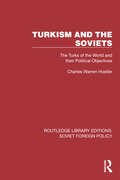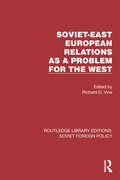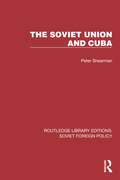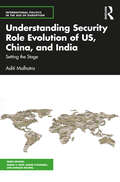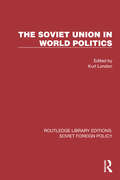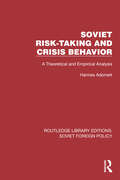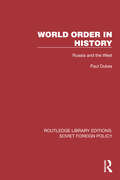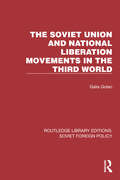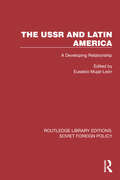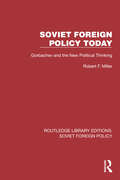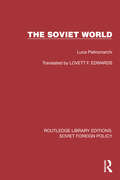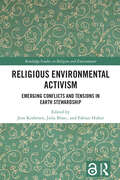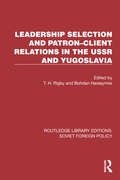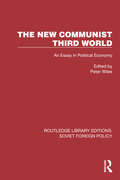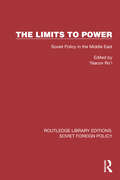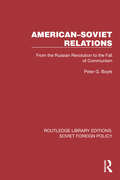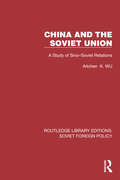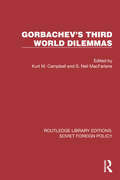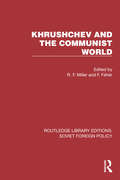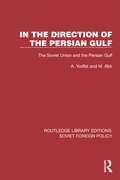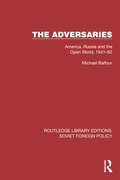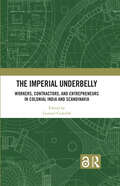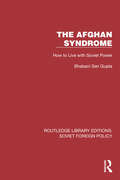- Table View
- List View
Turkism and the Soviets: The Turks of the World and Their Political Objectives (Routledge Library Editions: Soviet Foreign Policy #24)
by Charles Warren HostlerTurkism and the Soviets (1957) uses Turkish, Russian and Western sources to present a remarkable study of the Turkish world and its importance in international relations. It thoroughly examines the two factors which give this huge ethnic group its great importance – the strategic position of their territories and secondly their homogeneity and common objectives. Throughout this book the role of the Turkish peoples is examined as an issue intimately connected with the problem of the USSR and Communism. The southern border of the Soviet Union divides the Turkish world into two halves and partially cuts through the living area of the Turkish people. This is the area which contains the most important Soviet oil fields. The section of the book which deals with the splintering away of the Turkic portions of the USSR is of vital importance.
Soviet-East European Relations as a Problem for the West (Routledge Library Editions: Soviet Foreign Policy #23)
by Richard D. VineSoviet-East European Relations as a Problem for the West (1987) analyses the evolution of Eastern Europe both internally and in its relationship with the Soviet Union, the development of relations between the two superpowers, and the equilibrium between the two security systems. It examines how these changes have altered Western policy options, how internal Western frictions, arising from differing interpretations of these developments, can best be managed, and the most appropriate future policies both to achieve Western goals and to benefit Eastern Europe.
The Soviet Union and Cuba (Routledge Library Editions: Soviet Foreign Policy #16)
by Peter ShearmanThe Soviet Union and Cuba (1987) examines the thesis that Cuba acted as an extension of Soviet foreign policy or surrogate of the USSR in the Third World. The Soviet-Cuban link is assessed in four conflicts: Angola, Ethiopia, Grenada and Nicaragua. It is shown that Cuba is largely an autonomous actor in international relations, and that bilateral influence flows in both directions. Thus Western reaction to Cuban and Soviet activity in the Third World is often based on misperceptions.
Understanding Security Role Evolution of US, China, and India: Setting the Stage (International Politics in the Age of Disruption)
by Aditi MalhotraThis book revolves around the altering security roles of three pivotal powers – the US, China, and India. Each of these actors has experienced incremental changes in their external roles and behaviour over the last two decades, which are determined by the range of domestic and international factors. As each country works towards performing its revised security roles, the policymakers are subject to dilemmas and challenges that impact policy implementation and conduct. Using the framework of role theory, the book analyses the role evolution of these countries and elucidates its link with their security policies in the Indo-Pacific and on the global stage. In the process, it also examines the systemic and sub-systemic factors that determine the foreign and security behaviour of these critical Indo-Pacific countries. Accessibly written, this volume will be of great interest to scholars and researchers of international relations, security and intelligence studies, political science, and foreign policy. It will also be of great interest to policymakers, career bureaucrats, security and intelligence practitioners, and professionals working with think tanks and embassies.
The Soviet Union in World Politics (Routledge Library Editions: Soviet Foreign Policy #21)
by Kurt LondonThe Soviet Union in World Politics, first published in 1980, looks at the change in direction of Soviet foreign policy away from world revolution in the 1970s. Examining the impact of Soviet policies and actions on key nations and regions throughout the world and highlighting their significance as agents for change in the international arena, the authors present an overview of world politics, as well as an in-depth study of Soviet international behaviour.
Soviet Risk-Taking and Crisis Behavior: A Theoretical and Empirical Analysis (Routledge Library Editions: Soviet Foreign Policy #15)
by Hannes AdomeitSoviet Risk-Taking and Crisis Behavior, first published in 1982, examines the question: for what purposes and under what conditions were Soviet leaders prepared to take risks in international relations? The first part of the book sets out to define the concept of risk and to examine its analytical relevance for foreign policy, its measurement and its relation to the dynamics of crisis. The second part consists of in-depth analysis of Soviet behavior in the Berlin crises of 1948 and 1961. The third and last part compares Soviet policy in the two crises, and the actions of the two different leaderships, as well as relating it to Soviet behavior in other geographical areas.
World Order in History: Russia and the West (Routledge Library Editions: Soviet Foreign Policy #26)
by Paul DukesWorld Order in History (1996) argues that historians’ ideas about world order have been influential in transforming nations’ sense of themselves, and it pursues these arguments with particular reference to Russia and the Soviet Union and the Western world.
The Soviet Union and National Liberation Movements in the Third World (Routledge Library Editions: Soviet Foreign Policy #19)
by Galia GolanThe Soviet Union and National Liberation Movements in the Third World (1988) is a systematic comparison of Soviet theory about, and actual behaviour toward, movements for national liberation in the Third World. In this definitive study, Professor Golan demonstrates that Soviet behaviour toward such movements is consistent with Soviet theory as stated in the writings and speeches of high-level influential within the Party, military and academic communities. In so doing, she advances our understanding of the ‘rules of thumb’ that Soviet leaders appeared to follow in deciding whether and how to assist the varied types of ‘anti-imperialist’ and separatist movements in the developing world. The first part of the book provides a detailed analysis of the various schools of thought among Soviet writers concerning different aspects of national liberation movements, and the second part analyses actual Soviet behaviour toward numerous movements around the world.
The USSR and Latin America: A Developing Relationship (Routledge Library Editions: Soviet Foreign Policy #25)
by Eusebio Mujal-LeónThe USSR and Latin America (1989) is an authoritative analysis of the Soviet Union’s strategy and policy towards the region. The contributors cover a variety of topics, including Latin America’s place in Soviet strategy for the developing world, US perceptions of Soviet strategy in the region, Soviet–Cuban relations, and relations between Latin American communist parties and the USSR.
Soviet Foreign Policy Today: Gorbachev and the New Political Thinking (Routledge Library Editions: Soviet Foreign Policy #14)
by Robert F. MillerSoviet Foreign Policy Today (1991) is the culmination of almost 30 years of observations of Soviet foreign and domestic politics, written at the time of Gorbachev’s great changes. It locates the changes of Gorbachev in the context of the traditional goals and practices of Soviet foreign policy, and it does not shy away from presenting seemingly controversial interpretations of the USSR’s international politics.
The Soviet World (Routledge Library Editions: Soviet Foreign Policy #22)
by Luca PietromarchiThe Soviet World, first published in 1965, examines both the domestic society of the Soviet Union under Khrushchev and its foreign relations with the capitalist world. Khrushchev offered a challenge to the West, to compare the practical benefits to the people of communism and capitalism, and his foreign policies as much as his domestic policies aimed to prove the Soviet Union’s economic superiority to the United States.
Religious Environmental Activism: Emerging Conflicts and Tensions in Earth Stewardship (Routledge Studies in Religion and Environment)
by Jens Koehrsen Julia Blanc Fabian HuberThis volume explores how religious and spiritual actors engage for environmental protection and fight against climate change. Climate change and sustainability are increasingly prominent topics among religious and spiritual groups. Different faith traditions have developed "green" theologies, launched environmental protection projects and issued public statements on climate change. Against this background, academic scholarship has raised optimistic claims about the strong potentials of religions to address environmental challenges. Taking a critical stance with regard to these claims, the chapters in this volume show that religious environmentalism is an embattled terrain. Tensions are an inherent part of religious environmentalism. These do not necessarily manifest themselves in open clashes between different parties but in different actions, views, theologies, ambivalences, misunderstandings, and sometimes mistrust. Keeping below the surface, these tensions can create effective barriers for religious environmentalism. The chapters examine how tensions are manifested and dealt with through a range of empirical case studies in various world regions. Covering different religious and spiritual traditions, they reflect on intradenominational, interdenominational, interreligious, and religious-societal tensions. Thereby, this volume sheds new light on the problems that religions face when they seek to take an active role in today’s societal challenges.
Leadership Selection and Patron–Client Relations in the USSR and Yugoslavia (Routledge Library Editions: Soviet Foreign Policy #9)
by Rigby T. H. Harasymiw BohdanLeadership Selection and Patron-Client Relations in the USSR and Yugoslavia (1983) examines the system of nomenklatura, the semi-secret network of quasi-bureaucratic rules and personal relationships through which careers in Soviet politics were managed. Other Communist countries took the USSR as their prototype and their patronage relationship systems are included in this study.
The New Communist Third World: An Essay in Political Economy (Routledge Library Editions: Soviet Foreign Policy #11)
by Peter WilesThe New Communist Third World (1982) discuss the economic policies of the Soviet Union towards the countries of the developing world adopting a Marxist-Leninist form of government. The authors demonstrate as well the variety of political systems covered by the term Communism, and provide an interesting counter-balance to traditional views of the Third World and aid policies.
The Limits to Power: Soviet Policy in the Middle East (Routledge Library Editions: Soviet Foreign Policy #10)
by Yaacov Ro’iThe Limits to Power (1979) analyses the spectrum of Soviet interests and policies in the Middle East following the Yom Kippur War of October 1973: how the Soviets handled the oil question, military and economic aid, policy toward Egypt, Syria, Iraq, the Palestinian organisations – and toward Israel itself. The Soviet position in the Middle East in 1970 was as the dominant foreign power in the region, and this book examines the events and actions that resulted, under a decade later, in such a sharp reversal in Soviet fortunes. The ebb-and-flow of Soviet diplomacy, as it emerges from the wealth of official statements and press material, is examined in detail.
American–Soviet Relations: From the Russian Revolution to the Fall of Communism (Routledge Library Editions: Soviet Foreign Policy #3)
by Peter G. BoyleAmerican-Soviet Relations (1993) is a study of American policy towards the Soviet Union from 1917 to the fall of Communism. It attempts to understand what precisely were the roots of the Cold War and an analysis of the later relationship in the light of the Soviet Union’s evolution since the Revolution. It argues that American policy was shaped not only by the external threat from the USSR but also by internal forces within American society, domestic politics, economic interests, emotional and psychological attitudes and images of the Soviet Union.
China and the Soviet Union: A Study of Sino–Soviet Relations (Routledge Library Editions: Soviet Foreign Policy #4)
by Aitchen K. WuChina and the Soviet Union, first published in 1950, is written by a Chinese former diplomat and university professor, and calls on his many years of experience to provide an even-handed analysis of Sino-Russian relations. It ranges back to 1618 for some much-needed historical background, but the major part of Wu’s examination of the diplomatic relations between the two countries deals with the Soviet Union since 1918.
Gorbachev's Third World Dilemmas (Routledge Library Editions: Soviet Foreign Policy #6)
by Campbell Kurt M.Gorbachev's Third World Dilemmas (1989) examines the strategic, political and ideological criteria which shaped Soviet policies toward the developing world. Organized around particular themes and issues, it pays attention to both theoretical fundamentals in Soviet doctrine and to Soviet actions in specific regions. The topics range widely and include: the Soviet conception of regional security; Soviet arms transfers and military aid to the developing world; the developing world in Soviet military thinking; the USSR and crisis in the Caribbean; Soviet policy towards Southern Africa, notably Angola and Mozambique; and Soviet policy towards Southwest Africa. It looks at the activist foreign policy that Gorbachev inherited, and explores the elements of change and continuity that Gorbachev and the Soviets faced.
Khrushchev and the Communist World (Routledge Library Editions: Soviet Foreign Policy #8)
by F. FehérKhrushchev and the Communist World, first published in 1984, reviews the Khrushchev era, when the legacy of the Stalinist past was partly repudiated and the possibilities of reform within the USSR and the countries of the socialist camp were explored. The lessons derived from this exploration by Bloc leaders and Khrushchev’s successors unhappily led them to conclude that the scope for such reform was extremely limited. Many of Khrushchev’s reforms and reorganisation measures were indeed rescinded, but the notion had been planted that the naked terror of Stalinist rule and direct, centralised command over other socialist states were no longer feasible. This book reviews the evidence for this view both in internal terms and also in foreign affairs.
In the Direction of the Persian Gulf: The Soviet Union and the Persian Gulf (Routledge Library Editions: Soviet Foreign Policy #7)
by A. Yodfat M. AbirIn the Direction of the Persian Gulf (1977) analyses the Soviet Union’s interest in the countries of the Persian Gulf against the background of its relations with the Arab world, and the complexities of power politics. It examines, from the nineteenth century to the present, Russia’s involvement in and efforts to gain at least a foothold, if not control of this oil-rich region. Particular attention is paid to the Soviet’s interest in Persian Gulf oil, and Russian fuel resources are also discussed. Although bilateral and multilateral local relations are closely examined, power politics in general and in the region and the Indian Ocean are not neglected. In addition to Soviet sources, the authors have used the Arab and Western press, periodicals and monitoring services extensively.
Commonwealth and Independence in Post-Soviet Eurasia (Routledge Library Editions: Soviet Foreign Policy #5)
by Coppieters BrunoCommonwealth and Independence in Post-Soviet Eurasia (1998) examines the various attempts to create new forms of integration by the new states of Eurasia. The contributors to this volume analyse in detail how the national elites in the independent states conceived their regional policies. It looks in particular at the Russian-led Commonwealth of Independent States, feared by many of the newly-independent nations as being the Soviet Union Mark II.
The Routledge Handbook of US Foreign Policy in the Indo-Pacific
by Oliver Turner Nicola Nymalm Wali AslamThis handbook provides a comprehensive survey of US foreign policy throughout the Indo-Pacific. Home to around 60 percent of the world’s population; most of the world’s largest and fastest-growing economies; around half of the world’s states with full nuclear capabilities; and a complicated web of unresolved tensions, disputes, and conflicts, the Indo-Pacific is arguably the most diverse, dynamic, and contested region on Earth. US strategy there has evolved over centuries, with its physical presence going broadly unchallenged since at least the middle of the last century. However, the rapid development and expanding influence of China – alongside the growth of India, Indonesia, Vietnam, the Philippines, and others – as well as political and economic crises and disruptions within the United States itself, mean that in recent times the US has come to occupy a newly uncertain position and perceive a range of highly unfamiliar challenges. To explore how the US has managed, and continues to manage, its regional history, and how it approaches the modern-day landscape of an Indo-Pacific only recently normalised within international political discourse, the book contains 33 newly commissioned chapters from leading experts in the field. It does so partly with help from the more traditional realms of International Relations theory as well as more critical realms. It also unpacks US policy and strategy as it pertains to regional governments, states, and multilateral institutions, as well as to pressing issues including inter-state security, human rights, trade, artificial intelligence, and cyber strategy. It does so in four parts: • History of the US in the Indo-Pacific • Theorising US Policy and Presence in the Indo-Pacific • The US and Indo-Pacific States and Institutions • The US and Indo-Pacific Issues The book is designed to be of interest to students and scholars of the US in the Indo-/Asia Pacific; the international relations of the Indo-/Asia Pacific; and US foreign policy.
The Adversaries: America, Russia and the Open World, 1941–62 (Routledge Library Editions: Soviet Foreign Policy #1)
by Michael BalfourThe Adversaries (1981) examines the post-war world that both the US and the Soviet Union tried to mould in their own images. Their faith in their respective systems came at the cost of a political, economic and military clashing in various parts of the world, an antagonism that rendered the United Nations ineffective as an organ of world government. This book analyses these clashes, as the foreign policy decisions of both superpowers had wide-ranging effects over large portions of the globe.
The Imperial Underbelly: Workers, Contractors, and Entrepreneurs in Colonial India and Scandinavia
by Gunnel CederlöfThe volume introduces a new analysis of interconnected labour and economic history of colonial India and Scandinavia. From a recently found archive of a railway contractor’s private and business papers, the studies revise both Indian labour history and Scandinavian modern history, and ties south Sweden into the British Empire. With deep insights into everyday work practices of Indian and European contractors and manual labourers, the book establishes a bridge across the globe, between two poor regions as sites of extraction and industrial transformation, resulting from global migration and capital flows. Drawing on rich archival sources such as the Joseph Stephens Archive, Maharashtra State Archives, the National Archives of India, and the British Library, the book offers deep insights into everyday business practices of European contractors in India, which were rarely documented and have remained largely inaccessible so far. A unique look into the labour and entrepreneurship practices under British colonial rule in India, as well as its impact on the most transformative years of modern southern Scandinavia, the book will be of great interest to students, academics, and teachers of history, labour studies, subaltern studies, colonialism, imperialism, economic history, railways, economics, and Scandinavian and South Asian studies.
The Afghan Syndrome: How to Live with Soviet Power (Routledge Library Editions: Soviet Foreign Policy #2)
by Bhabani Sen GuptaThe Afghan Syndrome (1982) analyses and interprets the 1979 Soviet military intervention in Afghanistan and also examines its effects on America, China, India, Pakistan and other Islamic nations. It argues that one of the results was the rise of other centres of economic, political and military power outside the superpower spheres.
